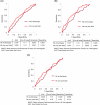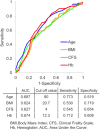Verification of haemoglobin level to prevent worsening of prognosis in heart failure with preserved ejection fraction patients from the PURSUIT-HFpEF registry
- PMID: 38952180
- PMCID: PMC11424383
- DOI: 10.1002/ehf2.14927
Verification of haemoglobin level to prevent worsening of prognosis in heart failure with preserved ejection fraction patients from the PURSUIT-HFpEF registry
Abstract
Aims: Anaemia has been reported as poor predictor in heart failure with preserved ejection fraction (HFpEF). The aim of this study was to evaluate the impact of changes in haemoglobin (Hb) from discharge to 1 year after discharge on the prognosis using a lower cut-off value of Hb than the World Health Organization (WHO) criteria.
Methods and results: First, 547 HFpEF cases were divided into two groups, Hb < 11.0 g/dL (n = 218) and Hb ≥ 11.0 g/dL (n = 329), according to Hb at discharge, and further were divided according to Hb 1 year after discharge into Hb < 11.0 g/dL (G1, n = 113), Hb ≥ 11.0 g/dL (G2, n = 105), Hb < 11.0 g/dL (G3, n = 66), and Hb ≥ 11.0 g/dL (G4, n = 263), respectively. Major adverse cardiovascular events (MACE) was defined as composite of all-cause death and heart failure readmission after a visit 1 year after discharge. The cut-off value of Hb was analysed by the receiver operating characteristics curve that predicts MACE. We examined the incidence rate of MACE between G4 and other subgroups and verified predictors of improving or worsening anaemia and covarying factors with change in Hb. In multivariate Cox proportional hazard model, MACE was significantly higher in G3 with worsening anaemia from Hb ≥ 11.0 g/dL to <11.0 g/dL than G4 with persistently Hb ≥ 11 g/dL (adjusted hazard ratio (HR): 3.14 [95% confidence interval (CI), 1.76-5.60], P < 0.001). MACE was not significantly different between G2 with improving anaemia from Hb < 11.0 g/dL to ≥ 11.0 g/dL and G4 (adjusted HR: 1.37 [95% CI, 0.68-2.75], P = 0.38). In multivariate logistic regression analysis, independent predictors of improving anaemia were male [odds ratio (OR): 0.45], chronic obstructive pulmonary disease (OR: 10.3), prior heart failure hospitalization (OR: 0.38), and estimated glomerular filtration rate (OR: 1.04). Independent predictors of worsening anaemia were age (OR: 1.07), body mass index (BMI) (OR: 0.86), clinical frailty scale score (OR: 1.29), Hb at discharge (OR: 0.63), and use of angiotensin-converting-enzyme inhibitor or angiotensin II receptor blocker (OR: 2.76). In multivariate linear regression analysis, covarying factors with change in Hb were BMI (β = -0.098), serum albumin (β = 0.411), and total cholesterol (β = 0.179).
Conclusions: Change in haemoglobin after discharge using a lower cut-off value than WHO criteria has prognostic impact in patients with HFpEF.
Keywords: Acute decompensated heart failure; Change in haemoglobin; Heart failure with preserved ejection fraction; Worsening and improving anaemia.
© 2024 The Author(s). ESC Heart Failure published by John Wiley & Sons Ltd on behalf of European Society of Cardiology.
Conflict of interest statement
Shungo Hikoso has received remuneration from Daiichi Sankyo Company, Boehringer Ingelheim Japan, AstraZeneca K.K. and Bayer, and research funding from Roche Diagnostics, FUJIFILM Toyama Chemical and Bristol Myers Squibb. Hiroya Mizuno has received a department endowment from Terumo. Yohei Sotomi has received remuneration from Abbott Vascular Japan, Boston Scientific Japan, research funding from Abbott Vascular Japan, and a department endowment from Terumo. Yasushi Sakata has received remuneration from Otsuka Pharmaceutical, Ono Pharmaceutical, Daiichi Sankyo Company and AstraZeneca K.K., and research funding from Otsuka Pharmaceutical, Daiichi Sankyo Company, Mitsubishi Tanabe Pharma Corporation, Astellas Pharma, Kowa Company, Boehringer Ingelheim Japan, and Biotronik. Other authors (Akihiro Sunaga, Shunsuke Tamaki, Masahiro Seo, Masamichi Yano, Takaharu Hayashi, Akito Nakagawa, Yusuke Nakagawa, Hiroyuki Kurakami, Tomomi Yamada, Tetsuhisa Kitamura, Taiki Sato, Bolrathanak Oeun, Hirota Kida, Tomoharu Dohi, Katsuki Okada, Daisaku Nakatani, Takahisa Yamada, and Yoshio Yasumura) have no conflicts of interest to report.
Figures





Similar articles
-
Post-discharge changes in nutritional status predict prognosis in patients with acute decompensated HFpEF from the PURSUIT-HFpEF Registry.Heart Vessels. 2025 Jul;40(7):577-591. doi: 10.1007/s00380-024-02499-y. Epub 2024 Dec 10. Heart Vessels. 2025. PMID: 39656282 Free PMC article.
-
Effective blood hemoglobin level to predict prognosis in heart failure with preserved left ventricular ejection fraction: results of the Japanese heart failure syndrome with preserved ejection fraction registry.Heart Vessels. 2019 Jul;34(7):1168-1177. doi: 10.1007/s00380-019-01349-6. Epub 2019 Jan 24. Heart Vessels. 2019. PMID: 30675647
-
Importance of non-cardiovascular comorbidities in atrial fibrillation and heart failure with preserved ejection fraction.ESC Heart Fail. 2025 Feb;12(1):389-400. doi: 10.1002/ehf2.15093. Epub 2024 Sep 21. ESC Heart Fail. 2025. PMID: 39305136 Free PMC article.
-
Characteristics and long-term prognosis of patients with heart failure and mid-range ejection fraction compared with reduced and preserved ejection fraction: a systematic review and meta-analysis.ESC Heart Fail. 2018 Aug;5(4):685-694. doi: 10.1002/ehf2.12283. Epub 2018 Apr 16. ESC Heart Fail. 2018. PMID: 29660263 Free PMC article.
-
Systematic review and meta-analysis to predict mortality in heart failure with preserved ejection fraction: Development and validation of the HF-DANAS score.ESC Heart Fail. 2024 Dec;11(6):4104-4115. doi: 10.1002/ehf2.15008. Epub 2024 Aug 8. ESC Heart Fail. 2024. PMID: 39118428 Free PMC article.
Cited by
-
The Critical Role of Comorbidities in Managing Heart Failure with Preserved Ejection Fraction (HFpEF).ESC Heart Fail. 2025 Jun;12(3):1541-1543. doi: 10.1002/ehf2.15169. Epub 2024 Nov 16. ESC Heart Fail. 2025. PMID: 39548848 Free PMC article. No abstract available.
References
-
- Hamaguchi S, Tsuchihashi‐Makaya M, Kinugawa S, Yokota T, Takeshita A, Yokoshiki H, et al. Anemia is an independent predictor of long‐term adverse outcomes in patients hospitalized with heart failure in Japan. A report from the Japanese cardiac registry of heart failure in cardiology (JCARE‐CARD). Circ J 2009;73:1901‐1908. doi:10.1253/circj.cj-09-0184 - DOI - PubMed
Publication types
MeSH terms
Substances
Grants and funding
LinkOut - more resources
Full Text Sources
Medical

